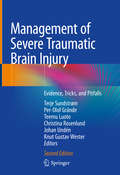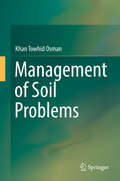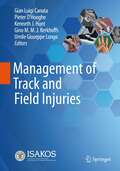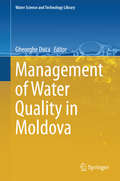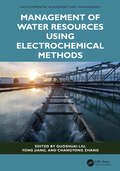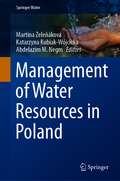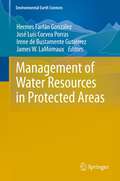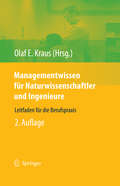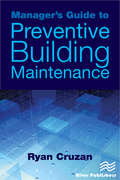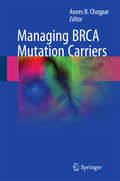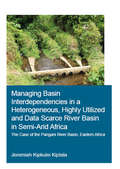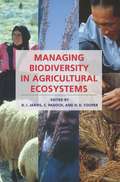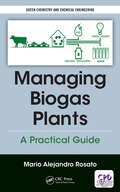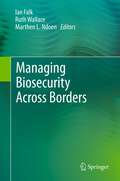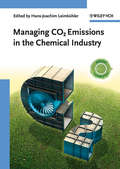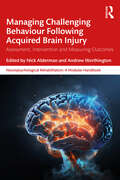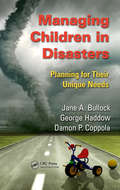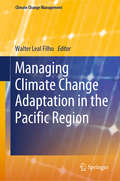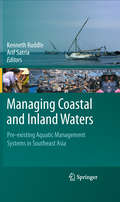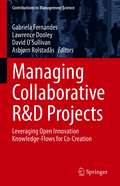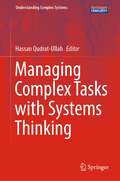- Table View
- List View
Management of Severe Traumatic Brain Injury: Evidence, Tricks, and Pitfalls
by Per-Olof Grände Terje Sundstrøm Teemu Luoto Christina Rosenlund Johan Undén Knut Gustav WesterThis comprehensively updated second edition features major revisions, 24 new chapters and more than 40 new authors, reflecting both the advances and key challenges within the field. Offering a systematic guide to the management of children and adults with severe traumatic brain injury throughout the entire chain of care, it includes evidence-based recommendations for each diagnostic and therapeutic measure, together with tips, tricks and pitfalls. The authors are all highly experienced clinicians and researchers who work with neurotrauma patients on a daily basis, and the editors represent the Scandinavian Neurotrauma Committee.The book helps professionals provide more systematic and higher-quality care in prehospital settings, primary hospitals, neurosurgical departments, neurointensive care units, and rehabilitation facilities. It is intended for all healthcare personnel involved in the multidisciplinary management of patients with head injuries, especially those in emergency care, neurosurgery, anesthesiology, radiology, and rehabilitation.
Management of Soil Problems
by Khan Towhid OsmanSoils are neither good nor bad, but some have inherent or acquired characteristics that may or may not suit our intended use. Unsuitable characteristics are considered to be soil problems, soil constraints or soil limitations. Only twelve percent of global land is right for agricultural production without much limitation. Some soils have severe limitations for crop production. These soils are so called ‘problem soils’. Many of them do not have enough fertility to be productive; some are arid and saline; some are very sandy and dry; and some are wet and waterlogged for most of the growing season. The global demand for food, wood, fuel, fiber, medicine and other plant products for the 7.2 billion current world population has created such an immense pressure on global soil resources that even the most fertile soils are losing their productive capacity. We are being compelled to bring more and more unsuitable or marginally suitable soils under cultivation. Unless innovative and integrated soil, crop and environmental management practices are adopted for their improvement and sustainable use, further degradation is inevitable. This book, Management of Soil Problems, identifies the problems and discusses management options in a smooth and reader-friendly style. It will be useful for students and professionals of soil science, agriculture, forestry, geography and environmental sciences.
Management of Sport Organizations at the Crossroad of Responsibility and Sustainability: Perceptions, Practices, and Prospects Around the World (Sports Economics, Management and Policy #25)
by Kirstin Hallmann Hanna Vehmas Suvi HeikkinenThis edited volume evaluates how sport organizations in the public, private, and non-profit sectors define responsible management and sustainability and what these mean in their daily operations. Using country-specific cases, the chapters provide an empirical investigation of sport organizations in each sector, analyzing managerial decisions and policies through a sustainability lens. All chapters are structured in the same way, providing a truly comparative approach. Offering insights for scholars interested in responsibility and sustainability in different context, this volume will be important to undergraduate and postgraduate sport management, event management, sport science, and sport study programs around the globe.
Management of Track and Field Injures
by Gian Luigi Canata Gino M. M. J. Kerkhoffs Kenneth J. Hunt Pieter D’Hooghe Umile Giuseppe LongoThis volume offers a comprehensive guide to the prevention, management of injury, risk factor mitigation, and rehabilitation in track and field athletes. It serves as a valuable resource for the sports medicine community, including surgeons, sports medicine physicians, physical therapists, and athletic trainers.In addition to addressing current management techniques for injuries, the book discusses various special considerations, e.g. biologics, the aging athlete, rehabilitation, nutrition, and gender.Published in collaboration with ISAKOS, this book offers an updated information authored by experts in the field, and a valuable contribution to the field of orthopedics and sports medicine.
Management of Waste to Control Environmental Pollutions: Sustainability and Economic Feasibility (Sustainable Landscape Planning and Natural Resources Management)
by Javid Ahmad Parray A. K. Haghi Nowsheen ShameemThis book analyzes the harmful effects of conventional waste treatments and pollution monitoring methods on the environment. It critically evaluates these methods and highlights their shortcomings that have significantly damaged the environment. The book provides a comprehensive overview of alternative waste and pollution treatment methods that can be adopted locally and internationally. It also examines appropriate resource management strategies for environmental issues and emphasizes the need for sustainable resource management practices. The book highlights the importance of education in achieving ecological sustainability, particularly in urban waste management. It elaborates on how education can raise awareness and promote sustainable waste management practices. Furthermore, the book presents the latest research topics, innovative ideas, and remediation strategies for various hazardous pollutants related to environmental issues and solutions. It provides a detailed analysis of the different remediation strategies and highlights their effectiveness in tackling environmental issues. The book also explores the innovative use of nanotechnology to achieve ecological sustainability and economic feasibility in wastewater treatment. One of the standout features of this approach is the use of microbial consortiums, which offer significant advantages over pure cultures. The need for hybrid treatment technology to effectively remediate different types of organic and inorganic pollutants from wastewater is also explored. In addition, the book highlights the application of green technology for waste management, providing innovative solutions using advanced green technologies that promote international cooperation and networking to achieve a sustainable environment. It covers advanced green technologies used to manage energy and bioproducts from waste, such as biofuel, biopolymers, fertilizers, and chemicals, without causing harm to the environment.
Management of Water Quality in Moldova
by Gheorghe DucaThis book deals with water management, one of the most challenging issues of contemporary society. Research and innovation in the field of water management must address certain fundamental aspects: access to water, water quality, water treatment, transboundary effect of water, etc. A comprehensive analysis was performed in a national research program of Moldova, entitled "Research and management of water quality". The main goal of the research program was to create and improve the legal, scientific and methodological, technological basis and sustainable development of water, implementation of modern technologies in water supply, treatment and reuse. Other priorities include expansion of access to water sources, improvement of environmental protection, especially water protection against pollution and depletion, efficient water use and establishing an effective monitoring system for disaster prevention. The topics concern research of water structure and quality, surface water, groundwater, water treatment, irrigation technologies and water pollution by remains from industry, one of the main environmental problems of our time. The book helps to get to coherent water policies of states.
Management of Water Resources Using Electrochemical Methods (Environmental Assessment and Management)
by Yong Jiang Guoshuai Liu Changyong ZhangThis book encompasses various approaches to electrochemical water treatment, emphasizing a well-structured framework within the nexus of electrochemistry, water, and energy. It addresses the urgent challenges of water scarcity and pollution and offers practical insights and operational guidance on removing pollutants and preserving water resources through water purification. Applications and real-life case studies support the innovative nature of electrochemical processes as a sustainable and efficient alternative. The user-friendly approach makes this book accessible to a broad audience, being a specialist seeking advanced techniques or a concerned citizen.Features Covers comprehensively the most recent and advanced electrochemical water treatment techniques. Presents practical operational guidelines and insights. Includes real-world examples and case studies. Focuses on environmental impacts and sustainability. Addresses innovative approaches in technology, theoretical computational analysis, and future development guidance for electrochemical water treatment. This book is for professionals, students, and researchers in water and environmental sciences interested in water treatment, management, and resource recovery. It is also a great resource for public and environmental health experts and readers who work in related disciplines and readers interested in water management, treatment, and the health of the environment.
Management of Water Resources in Poland (Springer Water)
by Martina Zeleňáková Abdelazim M. Negm Katarzyna Kubiak-WójcickaThis book contains a rich resource of essential information on the water resources capacities in Poland. This book contributes to the recognition of water resources management including extreme hydrological events such as floods and droughts. The book incorporates case studies illustrating solutions of water quantity management in Poland. This edited book covers all water bodies in the country including rivers, lakes, reservoirs and groundwater. The novelty of this book is that it represents the first time a manuscript covers the assessment of water resources in Poland, including variability, availability and economic use of the hydrological resources in the country with the lowest renewable resources of surface water per inhabitant in Europe. Given the depth and breadth of its coverage, the book offers engineers, researchers, policy planners, decision makers, and stakeholders essential new insights into efficient water resources management.
Management of Water Resources in Protected Areas
by James W. Lamoreaux Hermes Farfán González Irene de Bustamente Gutiérrez José Luis Corvea PorrasNatural ecosystems are heavily dependent on water, as it is essential to the development of life. The ecology and landscape play an important role in the quality and availability of water. It is no coincidence that exceptional hydrological phenomena are found in protected areas. Such is the case with, for example, the geothermic occurrences (principally, geysers) in America's Yellowstone National Park , the oldest park in the world. The Ramsar wetlands (where the ecosystem's dependency on water is strongly evident), The Iguaçu Falls (on the border of Argentina and Brazil), or the Zapata Swamp (the largest of its kind on the Caribbean island of Cuba) further exemplify this point. However, in many cases, the conservation strategies for hydraulic resources in protected areas are ignored, or simply deprived of the attention they require. There are many types of suitable management strategies for planning and protecting our valuable treasures. Hydraulic resource management in protected areas is something that must not be separated from these conservation measures. The first Symposium for the Management of Hydraulic Resources in Protected Areas was intended to be a framework of communication about experiences with water resource management in protected areas. Advances in research and possible solutions to the problems within these areas were discussed. The contributions in this proceedings volume are grouped under seven main themes: Purification and reuse of wastewater in rural communities; Impact of public use on water resources; Vulnerability and risks associated with aquifers, Design and management water resources in protected areas; Research and monitoring of water resources in protected areas; Water and its importance as a source of renewable energy in protected spaces; and Geodiversity and conservation of areas with hydraulic heritage.
Managementwissen für Naturwissenschaftler und Ingenieure
by Olaf E. KrausManagementwissen wird nicht nur in Wirtschaft und Industrie, sondern auch in der Forschung und bei Behörden mehr denn je vorausgesetzt. Diese Anforderung trifft Ingenieure und Naturwissenschaftler oft unvorbereitet. Das Buch ist in dieser Situation ein unentbehrlicher Ratgeber - ob beim Berufseinstieg, der Existenzgründung oder dem Karrieresprung. Für die Neuauflage konnte der Herausgeber neue Autoren aus dem ingenieurs- und wirtschaftswissenschaftlichen Bereich gewinnen. Der Schwerpunkt der Darstellung liegt auf Vorgehensweisen im Managementalltag.
Manager's Guide to Preventive Building Maintenance
by Ryan CruzanThis book is a comprehensive guide for developing an effective preventive maintenance program for any facility. Topics include facility inspection and assessment, effective lubrication practices, commercial roofing repair, indoor air quality management, applicable government codes, standards and regulations, detailed preventive maintenance procedures, and maintenance scheduling. Specific maintenance approaches are examined for more than 100 types of equipment and building components. Also discussed are the economic value of preventive maintenance, management and motivation of the preventive maintenance team, and setting up a computerized maintenance management system (CMMS).
Managing Ash from Municipal Waste Incinerators (Routledge Revivals)
by Alyce M. Ujihara Michael GoughOriginally published in 1989, this report deals with issues surrounding ash residues produced by municipal waste combustors. Spurred by huge disagreements over the environmental risks that these ash residues posed; Managing Ash from Municipal Waste Incinerators attempts to shed light on the debates around the issue and move forward towards an appropriate solution. This title will be of interest to students of Environmental Studies.
Managing BRCA Mutation Carriers
by Anees B. ChagparAs there are a number of nuances in terms of how to manage mutation carriers (both with and without a concomitant diagnosis of breast cancer), this text provides a comprehensive, state-of-the art review of this field. It represents a valuable resource for a myriad of clinicians and healthcare personnel who interface with these patients. The text discusses the latest recommendations for genetic counseling and risk assessment, provides a framework for considering reducing risk in mutation carriers who do not present with a concomitant diagnosis of breast cancer, and finally elucidates the many considerations of managing a breast cancer patient with a BRCA mutation. The text presents a multidisciplinary approach gleaning insights from imaging, breast surgery, gynecology, plastic surgery, medical oncology, radiation oncology and psycho-oncology. Managing BRCA Mutation Carriers will be a useful resource for physicians and healthcare providers from a myriad of disciplines who manage BRCA mutation carriers. All chapters are written by experts in their fields and include the most up to date scientific and clinical information.
Managing Basin Interdependencies in a Heterogeneous, Highly Utilized and Data Scarce River Basin in Semi-Arid Africa: The Case of the Pangani River Basin, Eastern Africa (IHE Delft PhD Thesis Series)
by Jeremiah Kipkulei KiptalaFor integrated water resources management both blue and green water resources in a river basin and their spatial and temporal distribution have to be considered. This is because green and blue water uses are interdependent. In sub-Saharan Africa, the upper landscapes are often dominated by rainfed and supplementary irrigated agriculture that rely on green water resources. Downstream, most blue water uses are confined to the river channels, mainly for hydropower and the environment. Over time and due to population growth and increased demands for food and energy, water use of both green and blue water has increased. This book provides a quantitative assessment of green-blue water use and their interactions. The book makes a novel contribution by developing a hydrological model that can quantify not only green but also blue water use by many smallholder farmers scattered throughout the landscape. The book provides an innovative framework for mapping ecological productivity where gross returns from water consumed in agricultural and natural vegetation are quantified. The book provides a multi-objective optimization analysis involving green and blue water users, including the environment. The book also assesses the uncertainty levels of using remote sensing data in water resource management at river basin scale.
Managing Biodiversity in Agricultural Ecosystems
by H. D. Cooper Christine Padoch D. I. JarvisPublished in three other languages and growing, Managing Biodiversity in Agricultural Ecosystems takes a look at how farmers manage, maintain, and benefit from biodiversity in agricultural production systems. The volume includes the most recent research and developments in the maintenance of local diversity at the genetic, species, and ecosystem levels. Chapters cover the assessment and farmer management practices for crop, livestock, aquatic, and associated diversity (such as pollinators and soil microorganisms) in agricultural ecosystems; examine the potential role of diversity in minimizing pest and disease pressures; and present studies that exemplify the potential nutritional, ecosystem service, and financial values of this diversity under changing economic and environmental conditions. The volume contains perspectives that combine the thinking of social and biological scientists.Inappropriate or excessive use of inputs can cause damage to biodiversity within agricultural ecosystems and compromise future productivity. This book features numerous case studies that show how farmers have used alternative approaches to manage biodiversity to enhance the stability, resilience, and productivity of their farms, pointing the way toward improved biodiversity on a global scale. As custodians of the world's agricultural biodiversity, farmers are fully invested in ways to create, sustain, and assist in the evolution and adaptation of a variety of plant and animal species. Thus this text is mandatory reading for conservationists, environmentalists, botanists, zoologists, geneticists, and anyone interested in the health of our ecosystem.
Managing Biogas Plants: A Practical Guide (Green Chemistry and Chemical Engineering)
by Mario Alejandro RosatoThis practical manual provides basic theoretical knowledge about fermentative processes, biochemical laboratory techniques, and an arsenal of practical tricks, recipes, do’s, and don’ts for the biogas plant manager. It explains why some popular tests and techniques are unreliable, how to optimize the feedstock’s cost and the energy self-consumption of the digester, and how to analyze experimental error propagation and judge whether a marketing claim or a test result from the literature is correct. All examples are taken from the author’s experience as consultant in managing biogas plants in Italy and Spain. It features a glossary of technical jargon and useful reference tables and formulae. By following the procedures described in this manual, anybody can learn in short time how to become a "bacteria farmer."
Managing Biosecurity Across Borders
by Ian Falk Ruth Wallace Marthen L. NdoenManaging biosecurity is everybody's business. The book's multi-site, multi-sectoral research contributes to an holistic, evidence-based strategy for managing plant biosecurity in complex contexts. The intent is to provide a starting point for all stakeholders in the biosecurity endeavor - policy personnel at all levels of governance, planners and regional developers, non-government organizations, community groups and individuals - to plan localized strategies that 'fit' national needs and constraints and the way people live their lives. In putting forward a 'strategy', we draw on many disciplines and cultural perspectives on a problem that is fundamentally a multidisciplinary and global issue. At the same time, the contributing researchers remain aware that such a strategy is always subject to local contextual factors and influences, indigenous and local knowledge and culture, and is regarded as a tool for planning, always subject to change.
Managing CO2 Emissions in the Chemical Industry
by Hans-Joachim LeimkühlerThis unrivaled reference and handbook on this hot topic covers the technical and administrative aspects of CO2 emissions, with special reference to the chemical and petrochemical industry. It also discusses energy efficient design, cultural aspects and future developments, answering such questions along the way as:- How can I measure and demonstrate the CO2 emissions linked to my production?- How can I benefit from CO2 neutral investments using the UNFCCC frame?- How can I reduce or avoid CO2 emissions by technical measures and new processes?- If CO2 emissions cannot be avoided, how is the capture and storage of CO2 technically and economically feasible?- What are the upcoming technical developments regarding CO2 reduction?A highly useful, practical and essential information source on one of the most pressing environmental topics of our times.
Managing Challenging Behaviour Following Acquired Brain Injury: Assessment, Intervention and Measuring Outcomes (Neuropsychological Rehabilitation: A Modular Handbook)
by Andrew Worthington Nick AldermanThis empirically based book provides conceptual knowledge and practical advice to enable clinicians to implement evidence-based methods drawn from learning theory for managing the catastrophic effects of challenging behaviour as an enduring outcome of acquired brain injury (ABI). Based on a conceptual framework of neurobehavioural disability, the book takes a holistic case formulation approach, incorporating functional assessment procedures arising from the operant learning tradition that underpins the design of treatment interventions. It bridges the knowledge gap in uniquely providing a single resource to enable practitioners to implement evidence-based methods to better manage ABI behaviour disorders. The authors, who are leading experts in the field, have described a model of intervention based on a functional analytic approach to understanding behaviour within an operant learning framework. The chapters provide a step-by-step approach to assessment, formulation, intervention and evaluation of behaviour support plans, and feature examples for specific challenging behaviours in a variety of different contexts. The book is organised to support the use of this model through expert contributions concerning the origins of challenging behaviour, assessment methods and formulation, and interventions. The practical orientation of this book makes it an indispensable read for neuropsychologists, clinical psychologists and other rehabilitation specialists involved in the care of people with ABI as well as researchers in these fields.
Managing Children in Disasters: Planning for Their Unique Needs
by Damon P. Coppola George Haddow Jane A. BullockEach year, disasters such as house fires, car accidents, tsunamis, earthquakes, and hurricanes impact hundreds of thousands of children. Child victims can suffer disproportionately and the physical and psychological damage sustained can far outweigh the same effects in adults, often requiring years of therapy. Sadly, emergency planners to date have
Managing Climate Change Adaptation in the Pacific Region (Climate Change Management)
by Walter Leal FilhoThis book presents papers written by scholars, practitioners, and members of social movements and government agencies pursuing research and/or climate change projects in the Pacific region. Climate change is impacting the Pacific in various ways, including numerous negative effects on the natural environment and biodiversity. As such, a better understanding of how climate change affects Pacific communities is required, in order to identify processes, methods, and tools that can help countries and the communities in the region to adapt and become more resilient. Further, the book showcases successful examples of how to cope with the social, economic, and political problems posed by climate change in the region.
Managing Climate Change and Sustainability through Behavioural Transformation (Sustainable Development Goals Series)
by Parul RishiThis book addresses climate change and sustainability management from a transdisciplinary perspective which encompasses within itself how different humanistic disciplines can culminate with each other to move ahead with the agenda. Issues of adapting to climate change and sustainability management have been gaining global prominence over the past few decades. There have also been volumes of literature that highlight the technical dimensions of climate change and sustainability across regions and cultures. However, they have had limited strength to bring direct and desirable impact in promoting pro-climate action and sustainability behaviour. The major reason for this is limited inclusion of pluralistic perspectives into human cognition and affect, and resultant limited public acceptability. Although behavioural science as a discipline has taken a front seat in promoting behavioural transformation, the book argues that other humanistic fields of understanding like education, art, literature, philosophy, political science, sociology, economics, etc., have to be integrated in order to present a holistic standpoint to sustainability literature.
Managing Coastal and Inland Waters
by Arif Satria Kenneth RuddleBesides the erroneous assumption that tropical fisheries are 'open access', the cases demonstrate that pre-existing systems (1) are concerned with the community of fishers and ensuring community harmony and continuity; (2) involve flexible, multiple and overlapping rights adapted to changing needs and circumstances; (3) that fisheries are just one component of a community resource assemblage and depend on both the good management of linked upstream ecosystems and risk management to ensure balanced nutritional resources of the community; and (4) pre-existing systems are greatly affected by a constellation of interacting external pressures.
Managing Collaborative R&D Projects: Leveraging Open Innovation Knowledge-Flows for Co-Creation (Contributions to Management Science)
by Asbjørn Rolstadås Lawrence Dooley David O’Sullivan Gabriela FernandesCollaboration among industry, universities and research institutes plays a vital role in stimulating open innovation, which in turn leads to new products, processes, services and business models. This book brings together a number of real-life examples of how to govern and manage open innovation collaboration projects more effectively, and provides timely insights that project consortia, governance boards and funding agencies can directly apply to implement and monitor projects and achieve greater impacts. All papers were written by recognized leading authorities with extensive experience in governance and management, and reveal how to capitalize on the potential of open innovation.This book shares multidisciplinary research perspectives on the potential benefits and challenges of collaboration, project management, and open innovation, as well as the management of complex organizational cultures and governance models.
Managing Complex Tasks with Systems Thinking (Understanding Complex Systems)
by Hassan Qudrat-UllahThis book is about improving human decision making and performance in complex tasks. Utilizing systems thinking approach, this book presents innovative and insightful solutions to various managerial issues in various domains including agriculture, education, climate change, digital transformation, health care, supply chains, and sustainability. Practical insights and operational causal models are systematically presented. The key features of the didactic approach of this book are core knowledge, numerous tables and figures throughout the text, system archetypes, and causal loop models. This book serves as a text for college and university courses on Systems Thinking for Management Decision Making in Complex Tasks. Researchers use the developed “causal models” to design and evaluate various decision-aiding technologies. It is used as a source of practical information for a broad community of decision-makers, researchers, and practitioners concerned with the issue of improving human performance in complex organizational tasks.
